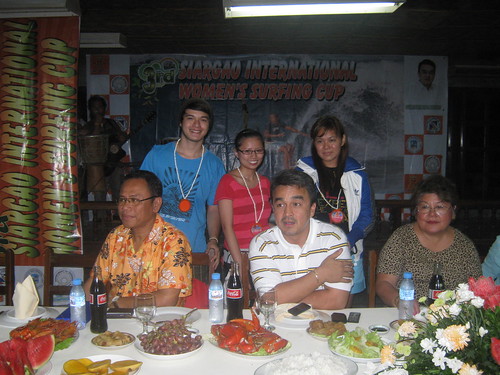 The dream of a nautical highway, linking thousands of islands throughout the archipelago, is slowly taking shape.
The dream of a nautical highway, linking thousands of islands throughout the archipelago, is slowly taking shape.For years, policy-makers have been talking about a waterborne transportation system that will facilitate cost-efficient flow of merchandise goods and unlock the huge potential for tourism offered by the country’s beautiful coastal towns.
The state-owned Development Bank of the Philippines, a strong supporter of this vision, is keen not just in funding key logistics projects but also in promoting roll-on roll-off (Ro-ro) ships as an attractive alternative for sightseeing backpackers.
Over the last four years, it has been holding “Ready Get Set Ro-ro” – an inter-island race patterned after the “Amazing Race” on cable television.
Every year, hundreds of young men and women vie for limited slots and get a shot at winning the P1-million grand prize. In that race, those lucky enough to join will get to sail to summer hotspots, meet new friends and watch their adventures aired on national TV.
This year’s six-day race saw 30 participants divided into 10 teams, drumming up attention in every port, from the time they boarded and disembarked from the Ro-ro to the execution of various mental and physical challenges.
Drinking in the local flavor
“This is, in fact, the essence of the race – to promote and boost trade and tourism through the use of the Ro-ro terminal system and the nautical highway,” DBP president Reynaldo David said during the awarding ceremonies of this year’s race held in May.
“The Ro-ro certainly appeals to tourists who want to make the most of their vacations. Not only is it cheap, but the Ro-ro allows tourists to visit as many cities and villages as they want, drink in the local flavor, steep themselves in the rich cultures and traditions of our provinces, enjoy the breathtaking scenery of our islands. They can just bring their car and park it inside a Ro-ro vessel,” he said.
Ro-ro vessels are designed to carry vehicles from one island to another. Automobiles, trucks and even railroad cars roll on or off the ship using ramps that are lowered when the vessel comes to port.
Traders may also get to reduce distribution costs by shipping their goods via Ro-ro vessels to any point in the country.
“It’s cheap, convenient and it certainly makes good business sense to ship your cargo rather than fly them, for instance,” David said. “This is the beauty of the Ro-ro, which we are highlighting through this inter-island race. With the Ro-ro, we are providing our countrymen with a cheap and convenient alternative to travel [these islands].”
Island-hopping
This year, the competitors started the race in Siargao, the country’s surfing capital. Then they hopped to Surigao del Norte before heading north to Leyte. In the course of the six-day race, they had to board Ro-ro vessels no fewer than nine times to get to Cebu, Negros, Panay and Mindoro. Last stop was Batangas in Luzon.
This year’s grand prize was bagged by a team led by 32-year-old sportscaster/commercial model Reema Chanco. The two other members of her team “Beach Hotshots” were cousins Jamielyn Ira Dy, 23, and Jethro Lloyd Tan, 24.
Team “Aquaholics,” composed of Pinoy Big Brother (PBB) Teen edition Season 2 finalist Josef Elizalde and running photographers Trisha Halili and Lea Aspe, clinched second place with P500,000. Team “Wave Catchers” with “Streetboys” member Danilo Barrios and Cebuano lawyers Mike Gatchalian and Tine Naranjo took third place for a P300,000 win.
Team “Summer Breezers” with “I love Betty La Fea” star Thou Reyes and girl buddies Chal Lontoc-del Rosario and Joei Calixto got fourth place, while fan favorite team “Fun Explorers” with surfer dudes JP and Aston Sarmiento and PBB Teen Edition housemate Nicole Uysiuseng came in fifth, taking home P75,000.
Other celebrity participants this year were former Pinoy Big Brother (PBB) Season 1 housemate Cassandra Ponti, ABS-CBN artists Eda Nolan and Rodjun Cruz, Viva Hot Babe Hazel Cabrera, and Serena Dalrymple, a commercial model and former child star.
Catching crabs
From the opening ceremonies in Siargao, the teams raced to their first clue, mounted on top of poles which they had to climb. The clue led them to a fenced area where, in the Surigaonon tradition of harvesting crabs called “tikyabang,” the contestants had to catch 10 crabs.
From the crabbing pit, the teams had to race to the Siargao Inn for their next checkpoint There they had to eat 10 pieces of the local surfboard-shaped bread known as “Pan de Surf.” Then they’re off to the Jacking Horse surf site, where a team member had to paddle a long board.
Teams then rallied to the pit stop set at the Gen. Luna Church.
Day 2 was a long and event-filled day for the racers as they covered two legs.
After they were delayed for an hour in Ormoc due to a sudden downpour, the racers boarded the Super Shuttle Ferry to Camotes Island.
On board, they had to search the vessel for a set of puzzle pieces which they had to assemble to form a picture of the ferry.
Fish traps
Shortly after sunset, the racers landed on Camotes Island and took off for the next leg of the race. At the Buho Rock Resort, teams had to slide down to the pool, swim to the fish traps and transfer fish from the trap to their fish net. Then they had to climb back up to have the fish checked by a marshal before returning to the port for the pit stop.
The adventure continued in San Carlos City, Negros Occidental, where teams had to run to the gymnasium and manually remove peanuts from their shells, and ride the “trisikad” to the People’s Park where they had to learn the basic steps of the Pintaflores Dance.
Then they had to race to city hall, which served as the pit stop for this leg of the race.
The island paradise of Boracay was the site of the fifth leg. The Caticlan port was the starting point for this leg, where racers had to ride the “paraw” from Caticlan to Station 2. There they had to paddle kayaks to three buoys to retrieve the money they would use to pay the entrance at Mt. Luho, the highest peak in Boracay.
Leg 6 was set in Matabungkay, where participants had to gulp down three cups of barako coffee at the local market, then wrestle with pigs for their next clue.
The race home
Then the teams had to get on a balsa and steer it to a point offshore before heading back to the beach.
From Matabungkay, Batangas, the five teams headed to Rizal Park for a final challenge.
Once at the park, the participants would have to trace the race route at the floating relief map of the Philippines.
After that, they proceeded to Reposo Street in Makati City for the final dash toward the pit stop at the DBP head office.
“More than the prize, it has been a rewarding experience to visit different provinces and get to know the people there and what they have to offer,” said Thou Reyes of team Summer Breezers.
The adrenaline rush, the heated competition, the camaraderie among participants, the breathtaking sights, the mouthwatering delicacies, the hospitality of local townsfolk and the adventure itself were just some of the things the participants would remember for a long, long time, David said.
The DBP executive is so pleased with the warm reception to this project that he wants to scale up the promotion of Ro-ro beyond the annual inter-island race.
He said the bank would soon publish pamphlets containing local inter-island Ro-ro routes, details on fares, island activities, suggested dining places and where to stay in a particular coastal hotspot. (inquirer.net)








No comments:
Post a Comment